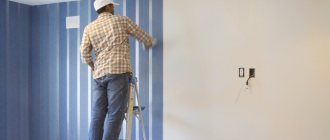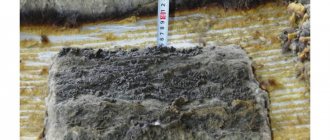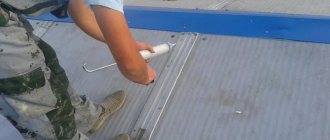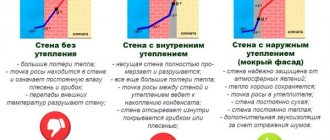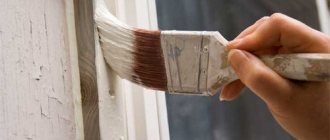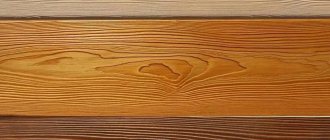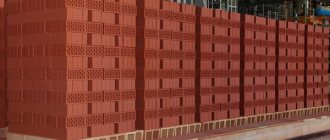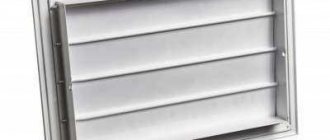Waterproofing walls is a mandatory procedure when constructing a building. Unprotected surfaces will be exposed to moisture - precipitation, condensation - and deteriorate, and mold may appear on them. When carrying out work, it is necessary to strictly adhere to the technology; this is the only way to ensure protection of brick, wooden or concrete surfaces from water, extending the service life of the house.
Application of liquid waterproofing
Sources of moisture
Condensation forms on the internal surfaces of the walls in the room. This occurs due to increased air humidity. In bathrooms, kitchens, basements, non-residential buildings (garage, shed, workshop), especially if they do not have a heating system, air humidity is constantly increased, so protecting the walls from the inside is mandatory.
Another reason for the appearance of condensation is insufficient quality insulation of the house.
External surfaces come into contact with precipitation and groundwater.
Consequences of depressurization of façade seams
The first signal of damaged waterproofing is a white “salt” coating on the exterior of the facade. The cracks that appear allow moisture to enter, which leads to unpleasant consequences, such as:
- Corrosion of metal frames in reinforced concrete structures;
- Loss of frame strength and occurrence of cracks;
- Loss of thermal insulation properties in residential premises;
- The appearance of leaks in the walls;
- Freezing of seams in the cold season;
- Formation of condensation on the inside of the wall;
- The appearance of brown damp spots on the walls and ceiling;
- Damaged wallpaper and crumbling plaster;
- The appearance of mold , mildew and unpleasant odor.
Timely waterproofing of the facades of apartment buildings will help prevent a number of unpleasant consequences. The procedure will provide reliable protection against damage due to water penetration and will increase the thermal insulation properties of walls, bases, and roofs. It will also reduce the level of humidity and minimize the likelihood of the formation of fungi and bacteria in the premises.
Why is waterproofing needed?
The absence of a waterproof coating will significantly reduce the service life of the building; the material (concrete, brick, wood) will deteriorate, cracks, mold, and moss will appear on it. To prevent this from happening, you need to waterproof the walls outside and inside.
In addition, protecting internal surfaces will help:
- prevent the appearance of damp smell;
- maintain an optimal indoor microclimate;
- protect pipes and other metal structures from corrosion;
- delay the need for cosmetic and major repairs.
average price
The average cost in the Russian Federation for the presented types of sealing is determined by product type, quantitative composition, purpose, and have different packaging by volume. For example, the price of any seal in rubles looks like this:
- Mastic (any type, but depends on volume):
- CJSC RASTRO (St. Petersburg) – 390.
- LLC TPK "MasticIzol" (Moscow) - 320.
- “The latest technologies” (Novosibirsk) – 430.
- Sealants:
- Stayer Master – 100-200 rub.
- TYTAN Professional – from 450 rub.
- BISON - on average from 120 rubles.
- Polyurethane foam:
- Penosil – from 350 rub.
- Soudal – from 350 rub.
- Moment - from 150 rubles.
- Tubular seal for 1 running meter. (the price depends on the diameter, the smaller it is, the cheaper the product):
- VILATERM (Moscow) - 30.
- Plant "Stroydetal" (Moscow) - 35.
- LLC “Unified Center for Waterproofing Materials” (Moscow) – 25.
Market prices for building materials are constantly changing and depend on many economic factors, as well as resource ones. It is most expensive to purchase material in the Moscow Region and St. Petersburg, and cheaper in the central zone of the Russian Federation (Vologda, Bryansk regions).
Types of waterproofing materials
According to their purpose, materials are divided into 4 types:
- sealing;
- anti-corrosion;
- hydro- and heat-insulating;
- antifiltration.
In appearance, waterproofing can be liquid or roll.
An example of using rolled waterproofing
Bitumen mastic
Bitumen is an elastic mass that is a product of oil refining. Creates a dense waterproof film on the surface and is not subject to cracking. Fills the smallest cracks, penetrates into the pores of the base. Used in combination with roll material or independently. Designed to protect the wall from the outside and treat the foundation.
Bitumen mastic is easy to apply; even a person with no experience can cope with the task. The work takes a little time. The material is sold in the form of bars, which must be heated to 150 degrees to melt before use.
The disadvantages include the duration of hardening. If low-quality compounds are used, the resulting coating may crack over time.
Polymer mastic
Polymer mastics are acrylic-based plastic adhesive compositions used for waterproofing walls from the inside or outside. In addition to protection from moisture, it improves the thermal insulation properties of the treated surface.
Advantages of polymer mastic:
- forms a dense, even coating that does not require finishing;
- fireproof;
- protects against moisture, fungus, moss;
- has a safe composition that allows its use in bathrooms and other rooms;
- Available in a wide range of colors;
- resistant to sub-zero temperatures;
- dries quickly;
- elastic, when the base dries or deforms, it retains its integrity.
Colored polymer mastic
Deep penetration compositions
Dry mixtures containing quartz sand, cement and polyurethane resins are diluted with water immediately before use. After drying, they form an airtight film that reliably protects the surface.
The application technology is extremely simple; the work can be performed by a non-specialist. Penetrating compounds are used primarily inside the home.
Roofing felt and roofing felt
Both materials are used to waterproof the outside of the wall and protect the foundation from moisture.
Ruberoid is a rolled material consisting of a base (cardboard, fiberglass) and impregnation (most often bitumen). Roofing felt is a cardboard sheet impregnated with a tar composition. The first is superior to the second in its properties; only it costs less.
Membrane (film)
It is a roll material made of synthetic rubber or PVC. Used indoors and outdoors. A significant drawback is instability to mechanical stress. Waterproofing film for walls can easily be damaged during installation.
Covering the foundation wall with a membrane
Injection waterproofing
This type includes:
- epoxy compounds;
- acrylate gels;
- polyurethane compounds.
Holes are drilled in the wall in increments of 50 cm into which liquid is injected under high pressure. The method is quite expensive and requires special equipment, so its use is justified only in very complex cases when it is impossible to use other materials.
Penetrating (penetrating) compounds
Based on quartz, cement, liquid glass and bitumen components. Suitable exclusively for reinforced concrete buildings and monoliths. In this case, they do not have to be leveled; it is enough just to open the pores and clean off the old plaster or screed. This can be done using chemical milling or a regular hard metal brush.
It is worth noting that the technology is applicable for both internal and external waterproofing. The compositions well plug capillaries and holes, making them practically impenetrable, and also increase frost resistance and resist the negative influence of an aggressive environment.
Often the material is a dry mixture, which is diluted and applied to the base with a roller or brush in several stages.
Application algorithm:
- Cleaning the wall from dust and dirt using sandblasting equipment or manually with stiff bristles;
- Primer;
- Application of penetrate;
- Sealing with sealants all joints, junctions and installation of elements.
The last stage is extremely important. Any seams and areas where communications exit are traditionally the weakest points. They must be opened and completely cleared of old contents.
After jointing, it is recommended to lay bentonite cord into the empty channels and additionally use injection (or cut-off) waterproofing. Its role is usually played by polyurethane expanding resin - it is pumped in by a pumping mechanism. After treatment with penetrate, the concrete must remain wet for 72 hours.
Location of insulation cover
Waterproofing a wall can be done in 2 ways: horizontal and vertical.
Vertical
This method is used both during the construction process and during renovation work. Use roll or liquid waterproofing material or both at the same time.
Horizontal
The rolled material is laid on the base where the wall is being built. Roofing material or film will prevent the absorption of moisture from the cellar, basement or soil.
Horizontal waterproofing
Installation of horizontal waterproofing is possible only at the construction stage.
PVC membrane
This is a polymer film up to 2 mm thick with antioxidant properties. It is durable, resistant to corrosion and rotting.
It has no adhesion to the surface, as it is mounted on a layer and requires welding the seams with hot air. The bulk of the work is performed automatically, and in places of junctions and difficult access, manual welding is used.
The technology gives an amazing effect: the welding seams are much stronger than the membrane itself; welding occurs at speeds of up to 6 meters per minute!
Unlike other methods, adhesives and solvents are not used here, and this guarantees complete tightness of the joint. The installation of PVC film is permissible in any climatic conditions, including frosty, humid weather: during welding, hot air dries and heats the film.
Mounting methods:
- Flat films (they have a corrugated surface) are laid on a dry, even and clean base. In order to hermetically insulate the surface, its sheets are laid with a 5-centimeter overlap and connected using special glue, tapes or welded.
- Self-adhesive membranes have an adhesive layer on one side, protected by paper, which is gradually removed during installation. After preliminary gluing, the sheet is pressed against the wall using a roller. The membrane can also be laid overlapping - without additional connection.
- The profiled membrane is attached to the base mechanically, most often using dowels with profiled washers, ensuring the tightness of the insulation at the attachment point. To connect the sheets, use profiled latches along the edges or laminated and paper-protected adhesive strips. The upper edge, protruding above the ground, is attached to the wall with special profiled clamping strips, which make it possible to remove moisture from under the membrane. It is important that the ventilation holes in the slats remain open during subsequent work.
Internal protection
Waterproofing of internal walls is carried out using polymer mastics or fixing the membrane.
Procedure for applying mastic:
- The prepared and cleaned surface is leveled with cement plaster.
- Apply primer.
- After drying, the surfaces are covered with a layer of waterproofing. In total, several layers will be required.
Polymer films are used for walls in an apartment or private house. Membrane installation:
- The sheathing is attached to the insulated surface.
- Insulation is placed in the cells between the racks.
- Using slats, the film is attached to the frame. Place it vertically, the stripes overlap.
- The cladding is carried out with finishing material.
If necessary, you can attach 2 layers of film - directly to the wall, before installing the sheathing, then to the frame itself.
Professional advice on choosing
We have prepared several useful videos for you. They contain advice from professional builders on the use of various waterproofing technologies. After getting acquainted with this material, you will better imagine the stages of work, and also get acquainted with some tricks that make it easier to apply waterproofing to walls:
Applying waterproofing indoors is an important component of finishing work. If you neglect this operation or violate technology in order to save money and time, the consequences can be extremely unpleasant. Carry out all stages of the work carefully and without unnecessary haste, and you will forget about problems with damp walls. Glad this result is worth the effort, isn’t it?
Features of waterproofing foundations and basement walls
The main feature of the foundation waterproofing process is that the surfaces requiring treatment are buried in the soil, and they will need to be cleared by digging a trench around the perimeter of the building.
Before starting work, you need to inspect the foundation and eliminate all defects.
Waterproofing of basement walls from the inside is carried out using bitumen mastic, roofing felt, and membrane.
Waterproofing a basement wall
Liquid rubber based on latex and bitumen
This is a thick black emulsion that is applied by hand or sprayed using special equipment. After hardening, it forms a high-strength seamless fabric that has 100% adhesion.
Thanks to its elasticity of 800%, it is completely resistant to shrinkage, structural deformation and mechanical damage, which is especially important in dynamic units. Before installing liquid rubber, the following requirements must be met:
- Remove dust, debris and finishing residues up to the floor slab;
- Dry with a gas burner (humidity should be no more than 15%);
- Seal seams and cavities;
- Make a fillet at the joints and areas of transition of planes.
On the inside of the object use:
Waterproofing of external walls
To protect external surfaces, you can use bitumen, roofing felt, or a combination of both.
Coating technology
Procedure:
- Cleaned surfaces are primed with a special composition (you can use bitumen diluted with gasoline). Apply the liquid with a brush. Wait until it dries. Apply a second layer.
- Cover with bitumen mastic preheated to a liquid state. If the composition is too thick and difficult to spread, add a small amount of solvent or gasoline to obtain the desired consistency. Particular attention is paid to the joints of the material from which the foundation is made.
- After applying the first layer, wait until it hardens. Cover with another one.
In order for waterproofing to perform its intended function, its total thickness must be at least 3 mm.
Pasting principle
Waterproofing the external walls of a house with rolled material is carried out as follows:
- The cleared surfaces are primed in 2 layers.
- Heat a strip of roofing felt or roofing felt using a hair dryer or burner. The impregnation needs to soften.
- Apply the material to the bottom edge of the surface horizontally (parallel to the ground).
- Press with force and carefully iron so that the roofing felt sticks tightly to the outer wall and there is no air left inside.
- The next strip is fixed vertically, with its lower end touching a horizontally fixed section of roofing material. The remaining strips are fixed in the same way, making an overlap of about 20 cm.
- The joints must be additionally sealed. Bitumen mastic is suitable for this.
Combined method
Waterproofing an external wall with roofing felt
For high-quality and reliable waterproofing of the walls of a house, you can use a liquid composition and rolled material.
In this case, first the surface is coated with bitumen mastic, and roofing material is laid on it.
The simplicity of the technology and the absence of the need to use special equipment make it possible to carry out work on protecting walls from moisture with your own hands, and the tangible benefits - a significant increase in the service life of the building - justify the investment of time and money.
How to make a hydraulic seal?
Titovite Member of FORUMHOUSE
Given: reinforced concrete M350 basement wall 30 cm thick. Apart from the basement with the ceiling, nothing was built. Waterproofing done. In the fall, at a level of -1.70 from the planning ground level, a leak occurred along a threaded rod (they remained in the concrete and served as a tie for sheets of plywood formwork). Most likely, rainwater is flowing under the waterproofing from above. When there is a house, this problem should disappear. I'm thinking about how to fix the leak now.
Thoughts like this:
- Hollow out the concrete in a circle around the stud to a depth of 10 cm.
- Cut off the stud by welding.
- Dust off and prime the resulting “crater”.
- Apply a hydraulic seal.
But the question is what to make it from. I think from a mixture of Portland cement, tile adhesive and liquid glass to the desired thickness. But maybe there are other proven recipes that are more effective?
Answer from a GLIMS expert.
— Your thoughts on the work execution system are correct, but may be temporary. Let's go in order:
- Hollowing out concrete to a depth of 10 cm is overkill; 3 cm (30 mm) is enough.
- Cut off the pin.
- Dust off and prime - in your case, priming is not only not necessary, but is more harmful than useful. Since you have M350 concrete, it is a high-strength concrete with a low degree of absorption. If you also prime it, you will further reduce absorbency. It is enough to saturate the concrete base with water and it will be better than priming.
- You don’t need to invent a hydraulic seal yourself - we did it many years ago. Our cement water seal is perfect for you - just for eliminating direct water leaks and sealing holes. You can even work underwater!
Question about waterproofing (waterproofing) that is done on the foundation - if water flows along the stud, it means that the external waterproofing has already been damaged. Having sealed one stud and blocking the ability of water to pass through, without solving the problem, the water will look for another place to exit and perhaps it will be a neighboring stud.
To check the quality of waterproofing on the foundation, block the access to rainwater from above. For example, cover your foundation with a durable film around the perimeter so that water cannot only flow in from above. In this way, we will understand where the water comes from - rain or groundwater.
